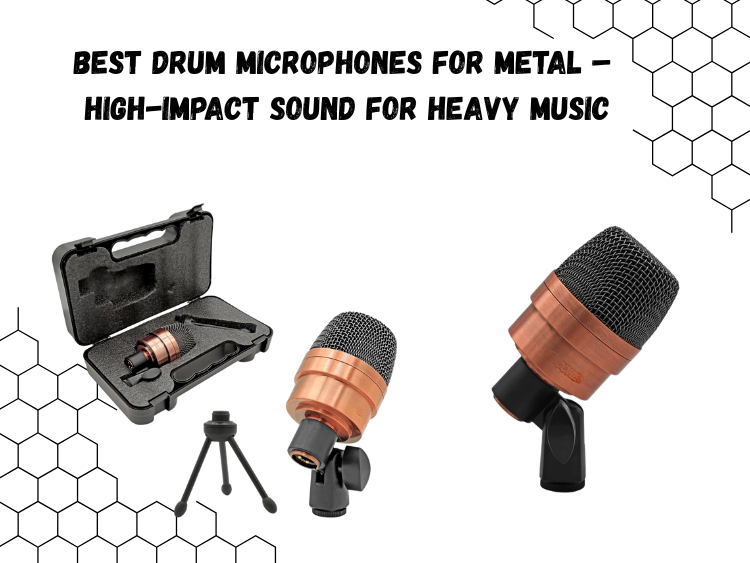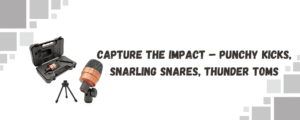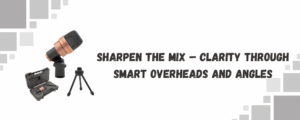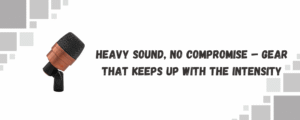When you’re playing metal, subtlety isn’t exactly the goal. You need mics that can take a beating and still deliver tight, punchy, in-your-face sound. Whether it’s thunderous kick drums, snarling snares, or toms that explode like artillery shells, your drum mics need to handle serious SPL, cut through layers of guitars, and capture every attack without flinching.
This guide strips it down and gives you what you actually need to know when shopping for the best drum mics for metal—no fluff, no sugarcoating.
What Makes a Drum Mic “Metal-Ready”?
Before you throw cash at gear, here’s what matters for heavy music:
- High SPL handling – Your drums are loud. Your mics better keep up.
- Focused pickup pattern – You don’t want bleed from cymbals or guitar amps ruining your tom tone.
- Fast transient response – Metal drumming is fast and aggressive. If a mic lags, it’s out.
- Durability – You’ll be playing hard. Your gear should be built like a tank.
Kick Drum Mics: Feel the Punch
The kick drum is the heartbeat of metal. You want low-end that punches you in the chest and enough definition to hear the click of the beater cutting through.
Look for a mic that emphasizes the low mids and upper attack around 4kHz–10kHz. Dynamic mics are generally the go-to here because they can handle the sound pressure and isolate that clicky punch.
Snare Mics: Crack, Snap, and Snarl
The snare in metal isn’t just a backbeat—it’s a weapon. You want a mic that captures the full body, but more importantly, delivers that aggressive crack without distortion or ringing overkill.
This 5 Core Tom & Snare Cardioid Dynamic Mic is made for that kind of work. With a cardioid pickup pattern, it zones in on your snare and rejects stage noise. The rugged build means it can take a rimshot without flinching, and its frequency response is tight enough to highlight that high-mid crack metal snares need.
Tom Mics: Controlled Chaos
Toms in metal aren’t just fills—they’re artillery. You want definition without mud, and a mic that can track fast rolls without smearing the transients.
Again, dynamic cardioid mics shine here. They isolate the source and minimize bleed from nearby cymbals. You don’t want overheads sneaking in too much trashy cymbal wash and masking your tom work.
A smart choice would be this 5 Core Tom & Snare Mic mentioned above. It handles floor toms just as confidently, keeping the boom tight and the attack clean.
Overheads: Keep It Controlled
In metal, overheads are less about ambiance and more about keeping the cymbals defined. You don’t need a room mic—what you want is clarity. Stick attack, shimmer, and zero wash.
Go for small diaphragm condensers with tight polar patterns. High-end clarity and fast transient response are key here. If your overheads smear, your whole kit turns to soup in the mix.
Hat Mics: Optional, but Nice
If your hi-hat is doing serious syncopation or timekeeping, a dedicated mic will help. But in most metal mixes, the overheads catch enough. Only mic it if your playing depends on detailed articulation from the hats.
Real-World Metal Setup Example
Here’s a no-nonsense setup that’s metal-ready:
- Kick – Large diaphragm dynamic with tailored low-end and upper-mid attack boost
- Snare – 5 Core Cardioid Snare Mic – clear attack, tight isolation
- Toms – Same 5 Core dynamic mic across the rack and floor toms
- Overheads – SDC pair, spaced wide for stereo imaging
- Hi-hat – Only if necessary, and use a tight-pattern condenser
This combo gives you punch, speed, and detail—without breaking the bank or overcomplicating things.
Don’t Overlook Mic Placement
You can buy the best mics in the world and still sound weak if your placement sucks. For metal:
- Kick – Inside the drum, aimed at the beater, adjust for more click or more thump.
- Snare – Slightly off-center, angled toward the center of the head. Keep the mic low but out of the drummer’s strike zone.
- Toms – About 1–2 inches above the head, aimed slightly toward the center.
- Overheads – Use the “recorderman” technique or spaced pair. Keep phase issues in check.
Final Thoughts
Metal drumming demands gear that can keep up. You’re not playing jazz brushes or soft rock grooves—you’re dropping sonic bombs. The right metal drum mics are the difference between a kit that sounds like cardboard and one that dominates the mix.
Start with the core pieces. That includes tough, reliable options like the 5 Core Tom & Snare Dynamic Microphone—built for heavy hitters, engineered to capture every detail without compromise. Combine smart gear with smart placement, and your drum sound will hit like a sledgehammer.




